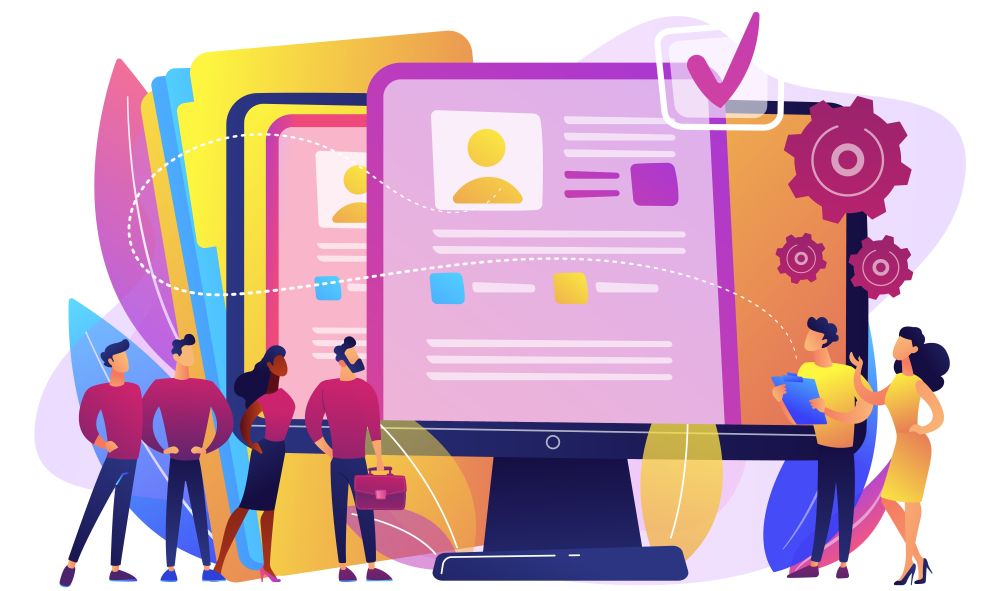Job Search: A Strategic Process, Not Just a Life Phase
Job search is no longer just a phase in life — it’s a strategic process that demands direction, emotional maturity, and modern skills.
Whether you’re looking for your first job, changing your career path, or returning to the market after a break, today’s successful job search doesn’t start with sending out your CV — it starts with self-awareness and focused planning.
At Digital Team, a company specializing in HR solutions and business consulting, we interact daily with both employers and talents. Our experience shows that modern job search success is less about “selling yourself” and more about knowing what you bring to the table — and what you’re looking for.
1. It All Starts With One Question: “What Do I Really Want?”
Sending out your CV everywhere is a common mistake. Effective job searching starts with self-reflection: What kind of role am I really looking for? What can I offer? What do I value — freedom, stability, meaning, or growth?
Our experts at Digital Team recommend starting with these self-assessment questions:
What are my strengths, and what do I want to improve?
What type of environment do I thrive in?
What compensation aligns with my expectations and market standards?
Only when you know what you’re looking for, can you truly find it.
2. Your CV & Cover Letter: Personal Tools, Not Formalities
Your CV is the first conversation you have with a potential employer. It should be clear — and tactfully bold. Every line should answer the question: “How can I add value to your company?”
Digital Team’s HR partners suggest:
Start with a clear professional summary at the top — who you are as a specialist.
Tailor your CV to each role — reflect the company’s needs and culture.
Write a cover letter that sounds personal, not templated — reflect your mindset and understanding of the company.
Your CV doesn’t have to be long. It has to be on point.
3. Personalized Job Search Is More Effective Than Mass Applying
Job searching isn’t a numbers game. What matters isn’t how many CVs you send, but how many reach the right people.
Our consultants advise taking a targeted approach: choose 10–15 companies you’d truly want to work for, and prepare accordingly — from a thoughtful LinkedIn message to a personalized email requesting an informal chat.
We call this a “proactive job search” — where candidates create opportunities instead of waiting for them.
4. Your Network Is More Than Just Contacts
A professional network isn’t just about who you know, but also about who knows you. Studies show that up to 70% of job opportunities are never publicly posted.
Digital Team recommends:
Reconnect with former colleagues, mentors, classmates.
Be active on LinkedIn — share insights, engage with others.
Attend events, workshops, and conferences — real-life conversations still win.
5. The Interview Is Not an Exam — It’s a Two-Way Choice
Candidates often forget that they’re choosing too. A job interview isn’t a request to be accepted — it’s an invitation to collaborate. Approach it as a professional conversation, with clarity on your value.
Our experts at Digital Team say: the strongest candidates are those who ask questions. Not just answering — but asking:
“What does success in this role look like?”,
“How do you measure growth in your team?”
These show strategic thinking and genuine interest.
6. Persistence Is Your Secret Weapon
Job searching can take time. Rejections are tough. But remember: not everything that doesn’t happen immediately is a failure.
Our HR specialists encourage candidates to stay focused: adapt your tactics, but don’t give up. Many success stories started with the 10th or 20th attempt.
7. The Future of Work Is Changing — But Humanity Remains Key
Technology, AI, remote work — all these are reshaping the labor market. Yet the fundamentals remain the same: reliability, curiosity, emotional intelligence.
Soft skills — resilience, empathy, adaptability — are becoming key hiring factors. At Digital Team, we already see companies prioritizing “the personal factor” just as much as professional experience.
8. Job Search as a Journey of Growth
This is a unique opportunity to grow — to reset, rethink your values, and develop new skills. Even if you feel uncertain now, every step is leading to new possibilities.
As your HR partner, Digital Team is here to support not just companies in finding the right talent — but individuals in finding the right place for themselves.
Follow our upcoming articles for more guidance — and remember: the job market is looking for you, just as you’re looking for the job.

The Ideal CV Structure for 2025: What Every Job Seeker Needs to Know
The job search landscape in 2025 is evolving. In addition to skills, experience, and motivation, one ability stands out more than ever: knowing how to present yourself clearly and convincingly. And it all starts with a well-crafted CV.
At Digital Team, an HR solutions and business consulting company, we review resumes from a wide range of industries daily — IT, manufacturing, e-commerce, executive recruitment, and more. Our experience shows that while visual styles are changing slightly, the core principles of an effective CV remain the same: structure, relevance, and clarity.
Below, you’ll find a comprehensive guide to help you create a CV that not only reflects your experience but also stands out in a competitive market.
1. The Purpose of a CV Is Not to Tell Everything — But to Prove You’re the Right Fit
Before jumping into structure, it’s essential to understand the real purpose of a CV: it’s not a biography, but a marketing tool — designed to spark interest and get you invited to an interview.
In 2025, more and more companies use ATS (Applicant Tracking Systems) — meaning your CV is first screened by a program, not a person. These systems scan for keywords and role-specific relevance.
That’s why structure, formatting, and clarity are now more crucial than ever.
2. The 2025 CV Structure: What You Must Include
A clearly structured CV makes your job search more effective. It should be optimized for both human readers and automated systems, which are often the first gatekeepers in recruitment.
Header & Contact Information
Full name (bold and large)
Professional email (avoid nicknames)
Phone number
City / country (indicate if you’re seeking remote roles)
LinkedIn profile link (and website/portfolio, if relevant)
Avoid outdated or irrelevant info such as ID numbers, nationality, or marital status — they’re not only unnecessary but may appear old-fashioned.
Professional Summary
A short paragraph (3–5 lines) at the top of your CV that summarizes:
Who you are professionally
Your core experience
What value you offer
Your career goals
Example:
Customer Experience Specialist with 7 years of experience in both B2C and B2B sectors. Skilled in developing results-driven communication strategies and increasing customer loyalty. Passionate about contributing to high-growth environments through impactful user experience design.
This section is your “first impression” and often determines whether the recruiter keeps reading.
Key Skills
Include 6–12 bullet points tailored to the job. Mix technical, software, language, and soft skills.
Example:
Project Management (Agile, Scrum)
Google Analytics & Data Studio
Public Speaking & Presentation
Customer Service Standards
English – C1 | German – B1
Tip: Match your wording to the job ad – this improves ATS compatibility.
Work Experience
Use a reverse-chronological order. For each job, include:
Job Title
Company
Location
Years worked
Brief company intro (optional)
Key responsibilities
Measurable achievements
Example:
Managed 3 marketing campaigns, resulting in an 18% sales increase in 6 months
Implemented a CRM upgrade, boosting customer retention by 22%
Focus on achievements, not duties. Results matter more than responsibilities.
Education
If you have 5+ years of experience, list only your highest completed degree:
Field of study
University
Degree type
Graduation years
Example:
Marketing Management | Vilnius University | BA | 2015–2019
Optionally, include:
Relevant coursework
Academic awards or distinctions
3. Additional Sections (Optional but Valuable)
Certifications (e.g., Google Ads, PMP, HubSpot)
Languages (state CEFR level: A1–C2)
Volunteering
Hobbies (only if relevant to leadership, communication, learning)
These extras reveal your values and mindset — sometimes they’re the tiebreaker in a competitive job market.
4. Visual Design for 2025: Less Is More
Your CV should be clean, professional, and ATS-friendly.
Digital Team recommends:
✅ Use PDF format
✅ Avoid multiple columns (they confuse ATS)
✅ Choose classic fonts: Calibri, Arial, Helvetica
✅ Use subtle color only for headings or accents
✅ Max length: 1 page (junior) / 2 pages (experienced professionals)
5. Common Mistakes to Avoid
Using the same CV for every job
Incorrect job titles or missing dates
Typos and grammar errors
Broken or outdated links
Vague language (“responsible for communication”)
Your CV is your personal brand. One careless error can cost you an opportunity.
6. What Hiring Professionals Say
Digital Team’s internal research shows:
CVs with measurable achievements are 2.7x more likely to land an interview.
Candidates who tailor their CVs for each role receive 3x more responses.
In 2024, 58% of companies adopted AI-powered recruiting tools, meaning machine-readability is becoming the norm.
7. Your CV Is Your Career’s Storefront
Writing your CV isn’t about telling your life story — it’s about convincing employers why you’re the right choice.
Every section is part of your professional narrative. A clear structure, tailored content, and professional language can turn your CV from “just another file” into a ticket to your next big opportunity.
At Digital Team, we help employers find the right talent — and we help candidates become impossible to ignore.
8. Tailoring Your CV for Each Role
One of the biggest mistakes job seekers make is using a generic CV for every application. Employers notice when candidates haven’t made the effort.
Every CV should be aligned to the job post — in tone, structure, and keywords. This is a non-negotiable step for serious candidates.
Strategic job searching requires strategic documents. A one-size-fits-all CV rarely works.
9. CV Add-Ons: Portfolio, References, Extra Materials
In 2025, employers often expect more than just a CV. Depending on the role, you may need:
Project samples
LinkedIn profile
Video introduction
If you have a portfolio — make it easy to access (link, QR code, or “one-click” format). If former employers can vouch for you — mention it in your “Additional Info” section.
Candidates who include relevant extras are far more likely to make the shortlist.
10. Language & Tone: Clear, Not Cold
Your CV is not an essay or sales pitch. Keep the language:
Professional
Action-oriented
Devoid of clichés
Avoid phrases like “creative, responsible, motivated.” Focus on action and outcomes.
Instead of:
“Motivated team player with excellent communication skills.”
Say:
“Led cross-functional team on X project, increasing efficiency by 25%.”
A great CV speaks confidently and clearly — without overselling.
11. Keep It Updated — Always
Even if you’re not actively job hunting, your CV should be up to date.
Why? Because opportunities come without warning — and you should be ready.
Digital Team recommends reviewing your CV every 3–6 months. Each new course, project, or achievement deserves a line. Being prepared means job search won’t feel like a crisis — it’ll feel like a natural step forward.

Job Search in the Digital Age: How the Rules Have Changed
Job searching today is fundamentally different from what it was 10 or 20 years ago. Back then, candidates would cut job ads out of newspapers, drop off printed CVs in person, or call company secretaries. Today’s job seekers face a very different reality — automated systems, artificial intelligence, and digital platforms.
While technology has made job hunting faster and more expansive, it has also introduced new rules and challenges. In this digital space, being a great professional is no longer enough — you also need to be visible to algorithms.
From Newspapers to LinkedIn: Where Job Searches Start Today
Fifteen to twenty years ago, job seekers turned to local newspapers, personal recommendations, or direct visits to companies. Today, the search begins online — typically on Google, LinkedIn, or job portals like CVbankas.
Job listings have become interactive and algorithm-driven — we often only see what the system thinks is relevant to us. That means your digital footprint directly influences your visibility and opportunities.
At Digital Team, we’ve observed a shift: more and more candidates start their search not by sending out CVs, but by updating their LinkedIn profile or even building a personal brand. Job search today is about strategic self-positioning — it requires vision, clarity, and the ability to communicate your value in a digital environment.
AI as the New HR Filter
One of the most significant changes in recruitment is the rise of ATS (Applicant Tracking Systems). These automated tools screen your CV before a human ever sees it. They look for specific keywords, structure, and phrasing that align with the job description.
In this context, job seekers must understand the basics of digital CV writing:
✅ Use clear job titles
✅ Include keywords from the job ad
✅ Avoid overly creative designs that might confuse the system
Digital Team HR professionals often see strong candidates lose out due to flashy, hard-to-read CV formats or poorly structured content. In the digital age, job search demands not just expertise — but technical literacy.
SEO for CVs and Google Visibility
A digital job search means you need to be found — much like businesses aim to be seen on Google. This has led to a growing trend: optimizing CVs and LinkedIn profiles with SEO principles.
Well-placed keywords, clearly outlined competencies, and a logical career path not only help ATS systems, but also make it easier for hiring managers to assess your fit.
Digital Team insight: more and more companies are googling candidates before reaching out. Your online presence matters — are you associated with industry insights or random forum comments?
Using AI Tools Like ChatGPT to Boost Your Job Search
AI has accelerated the job search process. Tools like ChatGPT can help you:
Draft personalized cover letters
Tailor your CV to a specific role
Prepare for interviews by simulating questions and answers
It’s important to remember: AI should be a tool, not a substitute for your personality. Digital Team recommends using AI to clarify your thinking and speed up tasks — but authenticity still matters most to employers.
Video CVs, Social Media Activity & Personal Branding
Job search is increasingly tied to personal branding. Social platforms are no longer just for leisure — they’re part of your career strategy.
Candidates are creating video CVs, sharing professional tips, writing mini-blogs, or commenting on relevant posts — especially on LinkedIn. All of this builds visibility and credibility.
Digital Team tip: employers don’t just read your CV anymore — they google you. Your digital behavior, from your profile picture to your comments on industry posts, contributes to your reputation.
A New Rule: The Candidate as a Content Creator
One major trend is positioning yourself through content. Candidates who share their insights, publish articles, or analyze market trends often appear more attractive. They demonstrate not only knowledge but also communication skills, leadership, and initiative.
Digital Team encourages job seekers to try bold formats — build a personal website, start a podcast, or record a short video introduction. In essence, job search has become a form of personal communication strategy.
The Rules Are Changing — But the Core Remains the Same
The digital age has made job searching faster, more automated, and more demanding. Yet the essence remains unchanged: at its heart, recruitment is still about a human-to-human connection.
The key difference? Today, building that connection requires strategy, digital fluency, and authentic content.
Digital Team’s perspective: those who thrive in the modern job market are not just technically skilled — they’re also emotionally intelligent and digitally aware. They use tools smartly, without losing themselves. And that’s the best rule of all for the new era.

The Cover Letter in 2025: Still Relevant or Outdated?
As job search trends evolve, so do the documents candidates submit. One of the most common questions today is:
Is the cover letter still relevant?
Is it worth writing if most employers don’t even ask for it?
The answer is yes — but with a few key caveats.
A cover letter is no longer just a formality. If written strategically, clearly, and — most importantly — personally, it can become a real competitive advantage.
At Digital Team, we often see that a well-written cover letter can be the difference-maker — the very thing that elevates a candidate from a generic CV pile. But to work, it must be written with intent, tailored for the situation, and grounded in value.
When Is a Cover Letter Worth Writing?
Not every job requires a cover letter. But there are cases when it’s strongly recommended — even essential:
✅ You’re applying for a role where communication, creativity, or initiative is key
✅ You’re changing career paths and need to explain your transition
✅ You don’t meet every listed requirement but have strong motivation and transferable skills
✅ You’re sending an open application to a company that hasn’t posted a job opening
In today’s oversaturated job market — especially for popular roles — a thoughtful cover letter helps create emotional connection and brings your story to life beyond your CV.
Even when a cover letter is “optional,” Digital Team experts agree: a good one never hurts. Often, it’s the very reason a candidate gets invited to an interview.
Structure Matters: Clear, Focused, and Value-Driven
One common mistake is treating the cover letter like a second CV — or worse, a vague essay about personal values. A good cover letter should answer two key questions:
Why you?
Why this company?
A recommended structure:
Opening – Who you are, what role you’re applying for, and why you’re writing
Why this role/company? – Refer to specific facts: their work, values, projects, or culture
What you bring – Key skills, experience, or achievements that match their needs
Closing – A respectful call to action (e.g., request for a meeting or call)
Keep it to one A4 page, ideally 3–4 short paragraphs — each with a clear purpose.
Think of it as an elevator pitch — concise, compelling, and tailored to spark curiosity.
Keywords: More Than Just SEO — They’re Psychological Signals
A great cover letter shows you understand the role. That’s where strategic keywords come in. Use terms that reflect the job posting — such as:
Project Management
Customer Service
Teamwork
Agile
Analytical Thinking
These words aren’t just for ATS — they also reassure hiring managers that you “speak their language.” But avoid mindless copy-pasting. It’s better to show than tell.
For example:
“Working with a remote, multicultural team where I had to resolve conflicts and manage deliverables taught me the true value of collaboration. That’s why your emphasis on cross-functional teamwork immediately stood out.”
Candidates who can translate their experience into the employer’s context always have an edge.
Personalization: Your Secret Weapon
A personalized cover letter isn’t a template — it’s a dialogue. Every company wants to feel chosen, not just contacted.
How to do it?
Research the company’s values, recent projects, and leadership posts on LinkedIn
Mention specific things that inspire you: innovation, sustainability, rapid growth, etc.
Avoid vague compliments like “You’re a market leader.” Instead say:
“I was impressed by your recent logistics initiative that combined efficiency with sustainability — it reflects the kind of impact I want to help build.”
Digital Team notes: personalization is not just about dropping the company name — it’s about matching tone, themes, and even writing style. A creative agency might welcome boldness, while a finance firm expects precision and professionalism.
Common Mistakes to Avoid
Even strong candidates fall into these traps:
Long, dry, or unstructured letters
One version sent to multiple companies
Talking too much about themselves — without showing value to the company
Grammar or spelling errors (especially in communication-focused roles)
A cover letter is your demo version — if it doesn’t create interest, it won’t be read further.
Tip: Read your letter aloud — it should sound natural, confident, and clear.
A Small Document with Big Impact
A cover letter can be the deciding factor — especially when many candidates seem equally qualified. It’s your chance to communicate your perspective, values, and voice.
Modern job search is no longer just about CVs — it’s about your entire candidate presence, and a great cover letter is a key part of that.
At Digital Team, we see that the most successful candidates know how to communicate clearly, personally, and purposefully.
If you have something meaningful to say — write it. A strong cover letter can open doors your CV alone cannot.

Job Interview Guide: How to Prepare and Stand Out
A job interview is far more than a formality — it’s one of the most critical stages of the job search. It’s where experience, communication, mindset, and presence intersect. While most interviews seem to follow a predictable structure, every conversation is unique.
At Digital Team, we’ve found that successful candidates aren’t the ones with perfect answers — but those who are prepared to speak honestly, strategically, and with clarity.
The Most Common Interview Questions — and How to Answer Them
Interview questions aren’t random. They’re designed to understand who you are, how you think, and how well you’d fit the company culture. Preparation often starts with the “classics” — but even these can be answered in ways that leave a lasting impression.
Here are some of the most frequent questions our consultants see:
“Tell me about yourself.”
Don’t recite your entire life story. Focus on 2–3 key professional facts, your current goals, and why you’re seeking this specific role.
“What are your strengths and weaknesses?”
It’s okay to mention a real weakness — as long as you show how you’re working on it.
Example: “I used to struggle with delegating tasks, but I’ve learned to do it effectively in team settings.”
“Why did you leave your last job?”
Avoid negativity. Even if the experience was difficult, focus on what you learned and what you’re looking for now.
“Where do you see yourself in 3–5 years?”
This reveals your ambition and strategic thinking. Employers want to know you have direction — and that this role fits into it.
Digital Team tip: Before the interview, create a “bank” of personal answers you can adapt. It helps you speak confidently without sounding rehearsed.
How to Answer: “Why Do You Want to Work Here?”
This is one of the most important — and most overlooked — interview questions. It’s not just about your motivation, but about how well you prepared.
A vague answer like “Because your company seems interesting” misses the mark. A strong answer is specific — based on your knowledge of the company’s values, culture, product, or mission.
Example:
“I read about your digital transformation over the past year, and I admire your openness to innovation. I’ve worked on similar initiatives and believe I can contribute both insights and hands-on experience.”
The more a candidate shows they’ve done their homework, the better the impression they leave.
Even 15 minutes on the company’s website or LinkedIn page can help you mention 2–3 concrete reasons why this role truly resonates.
Bonus: You can also tie in personal motivators — shared values, career growth, interest in specific tools, teams, or leaders.
Career Gaps & Frequent Job Changes: How to Explain Them
For many candidates, these are sensitive topics. But career breaks — for family, health, education, or life changes — shouldn’t be a red flag. What matters is how you talk about them.
Be transparent, and frame it as part of your growth:
“In 2019, I took a break to care for a family member. That time taught me resilience — a strength I now bring into every role.”
“Over the last 5 years, I held several positions while exploring my career direction. Each role helped me narrow my focus, and today I’m confident that I want to grow in data analytics.”
If you’ve changed jobs frequently, give context — such as project-based work, company restructuring, or your desire to learn faster than a previous role allowed. Focus on what you learned from each step.
Don’t apologize or hide facts.
A job interview is not an interrogation — it’s your chance to shape your career narrative as intentional and valuable.
Digital Team insight: The best candidates don’t have perfect CVs. They have a clear story, and they know how to tell it with purpose and self-awareness.
LinkedIn: Your Always-On Digital CV
Modern job search is less about sending out CVs and more about your digital presence.
LinkedIn isn’t just another platform — it’s your public, professional profile, and can act as your passive job agent, attracting recruiters even when you’re not actively looking.
A well-optimized LinkedIn profile helps you:
Get discovered in relevant searches
Join important discussions
Attract offers that never appear in public listings
In other words — it’s your CV, visible 24/7.
Crafting a Headline That Shows Your Value
Most people use job titles in their LinkedIn headline: “Marketing Specialist,” “Project Manager,” “HR Director.”
But this is your chance to stand out — to show your unique value proposition in a few words.
Instead of: “Financial Analyst”
Try: “Data-Driven Decision Maker in Finance | Excel & Power BI Enthusiast”
Instead of: “HR Manager”
Try: “People Strategy Expert | Team Culture Builder | Recruitment & Employer Branding Leader”
Use keywords that reflect not only your role, but your skills, mindset, and industry. This boosts your visibility in searches — and helps you rise above the crowd.
Your ‘About’ Section: Tell Your Story, Not Just Your Title
The “About” section is your opportunity to be more than a title or a list of duties.
A great summary includes:
Who you are, what drives you, and what you want to achieve
Key accomplishments, ideally with numbers: “increased sales by 40% in 3 years,” “saved 150 staff hours per month”
A short line about what you’re looking for or open to: “Exploring roles in IT project management”, “Open to international collaboration”
Be real. Be specific. Avoid clichés like “motivated professional with strong communication skills.” That says nothing.
Your goal: Sound like a real person — with clear expertise and direction.
Final Thoughts from Digital Team
The interview is your moment to connect — not just to impress. It’s where your story, intent, and presence come together.
Job search in 2025 is about more than experience — it’s about how well you communicate who you are.
At Digital Team, we’ve seen it over and over again:
The most successful candidates aren’t always the most qualified on paper — but the most self-aware, prepared, and authentic in conversation.
Experience Is Not Just a List of Job Titles
While LinkedIn allows you to copy and paste your CV into the experience section, it’s far more effective to treat it as a chance to showcase your impact.
Every position you list should answer three key questions:
What field did you work in?
What exactly did you do?
How did you contribute to the organization’s success?
Example:
Project Manager | UAB “X” | 2020–2023
Led the end-to-end delivery of three e-commerce projects. Implemented automation that reduced customer service response time by 25%. Collaborated with an international team (LT, DE, UK).
Use strong action verbs — led, developed, optimized, implemented — and back up your statements with measurable results. This builds trust and highlights your unique value.
Recommendations: Your Social Proof
LinkedIn’s recommendation section is often overlooked — but it’s a powerful asset. These testimonials from colleagues, managers, clients, or partners provide public confirmation of your work ethic, collaboration style, and results.
Why it matters:
✔️ It validates what you say about yourself
✔️ Recruiters often read recommendations when deciding who to invite for interviews
✔️ It shows you leave a positive impact — and that others are willing to vouch for you
Digital Team tip:
Ask for 2–3 recommendations from people you’ve worked with in the last few years.
And don’t forget to return the favor — write thoughtful recommendations for others whenever you can.
Engagement & Network Growth: An Investment in Visibility
LinkedIn’s algorithm rewards active users. You don’t need to become an influencer, but consistent activity — posting, commenting, sharing insights — increases your visibility and chances of being found.
Digital Team insight:
Job seekers who are active on LinkedIn tend to find jobs faster. Even if you’re between jobs, share takeaways from past experiences, comment on industry trends, and join meaningful conversations. It positions you not just as an employee, but as a thinking professional.
As for growing your network — don’t limit yourself to people you already know. Connect with:
Former colleagues
Industry peers
Mentors
Even hiring managers or business leaders in companies you admire
A broader network means more job visibility, more potential referrals, and more support when you need it.
Yes, SEO Matters — Even on LinkedIn
If you’re actively job searching, make sure your profile contains keywords that match how recruiters are searching.
For example, if you’re a marketing professional, include phrases like:
digital marketing, SEO, Google Ads, content strategy, social media campaigns.
This helps you appear in:
LinkedIn search results
Recruiter keyword filters
Algorithm-based candidate suggestions
Digital Team Insight: LinkedIn Is Not Just a CV Copy — It’s Your Personal Brand
We’ve seen it time and again — top candidates don’t always have the most impressive experience on paper. But they know how to represent themselves professionally and authentically online.
A strong digital identity is often the deciding factor — especially in competitive industries.
LinkedIn is not just a platform for job seekers. It’s the beating heart of the job market.
If you want to be noticed, remembered, and invited, your profile must be clear, active, and human. It should reflect not only your expertise — but your perspective, values, and presence.
Never leave your experience section blank.
When job searching becomes a priority, a well-optimized LinkedIn profile can mean the difference between “I heard nothing back” and “I received multiple offers.”

Freelance or Full-Time: What’s the Right Choice Today?
In the 21st century, job search is no longer limited to full-time positions with fixed hours from 9 to 5. More and more professionals are choosing freelance work — offering flexibility, autonomy, and the ability to work from anywhere in the world. At the same time, full-time employment remains attractive for many, offering security, steady income, teamwork, and opportunities for career growth.
So which should you choose in today’s job market, where “job search” can mean browsing listings — or pitching clients? Let’s explore the pros and cons of both models, who flexible work suits best, and how to balance multiple projects without burning out.
Full-Time Work: Stability, Structure & Team Belonging
Full-time employment is still the default model in much of the job market. While formats are changing (remote or hybrid work is the new norm), the core aspects of traditional employment remain consistent.
✔ Pros:
Financial stability – A regular salary allows you to budget, save, or take out loans more easily.
Social benefits – Health insurance, pension contributions, paid leave, maternity/paternity support — usually provided by the employer.
Career growth – Most organizations offer internal mobility and professional development pathways.
Teamwork – Daily collaboration fosters creativity, relationships, and shared motivation.
✖ Cons:
Less freedom – Time, project choice, and work style are often dictated by the organization.
Limited variety – Working for one company may lead to routine or fewer opportunities to try new directions.
Fixed earning ceiling – While stable, your income growth is typically slow and governed by company policy.
Freelance Work: Flexibility, Creativity & Autonomy
Freelancing means becoming your own boss — managing your time, projects, and finances independently. Job search becomes about building your client base, finding projects, and developing your personal brand.
✔ Pros:
Flexible schedule – Choose your hours, clients, and even your workplace — ideal for travelers or parents.
Higher earning potential – Successful freelancers can out-earn full-timers, especially with multiple high-value clients.
Variety – Working across projects and industries accelerates learning and builds a rich skillset.
Personal branding – Freelancing is a great way to build your name and reputation in your niche.
✖ Cons:
Instability – Projects can end unexpectedly, payments may delay, and clients can disappear.
No safety net – You’re responsible for taxes, insurance, retirement savings, and health coverage.
Loneliness & burnout – Working alone without peer support can be isolating, and long hours often lead to burnout.
Is Freelance Work Right for You?
Freelancing isn’t for everyone — it depends on your personality, habits, experience, and life stage.
Freelance may be a good fit if:
You’re self-motivated, disciplined, and can manage time without external pressure.
You have a clear skill set you can sell (e.g. design, development, writing, translation, consulting).
You want to travel or work on your own schedule (early mornings or late nights).
You already have a client base — or are ready to actively promote yourself (via LinkedIn, portfolio, personal website).
When Is Full-Time the Better Option?
Full-time work may suit you better if:
You value security, structure, and predictability.
You want to grow within a specific organization, learn from peers, and be part of a team.
Your career goals align with long-term commitment, company culture, or family responsibilities.
You struggle with self-organization, finances, or prefer not to deal with client acquisition.
Combining Both: Balancing Projects Without Burnout
Many modern professionals adopt a hybrid model — a full-time job for stability, plus side projects, consulting, or creative work. But balance is key — job search doesn’t always end with one offer. You’ll often need to decide: which projects to accept, which to decline, and when to pause.
Tips to avoid burnout:
Have structure – Even if working from home, allocate fixed time blocks for each project. Use calendars and planning tools.
Set boundaries – Flexibility doesn’t mean working 14 hours a day. Define and stick to your “work hours.”
Choose clients wisely – Not all projects are worth your time. Say no to low-paid or high-stress work that drains your energy.
Prioritize rest – Even without official leave, plan breaks: screen-free weekends, time in nature, family days.
Stay connected – Freelancing doesn’t mean isolation. Join communities, coworking spaces, or online groups — they provide both support and opportunity.
Choose Based on Your Values
Job searching today isn’t just “find a job – start working.” It’s a process of self-assessment and market awareness:
What do I want? What can I offer? How do I want to work? What conditions do I thrive in?
Freelancing is like running a business — you are the employer and the employee. It offers freedom and income potential, but demands discipline.
Full-time work means structure, systems, and stability. If you seek security and long-term planning, this might be your path.
Or maybe… both?
More professionals are blending models: secure employment plus creative or freelance work on the side.
The most important thing is to know yourself and choose the path that fits not only your financial situation, but also your emotional and personal rhythm.
Digital Team insight:
In a market with so many options, success belongs to those who make informed, aligned choices — not just based on trends, but on what truly supports their life and career goals.

TOP 5 Most In-Demand Professions in 2025 (Trends)
The modern job market is changing faster than ever. Digitization, artificial intelligence, the growth of e-commerce, and the remote work culture are having a major impact on job demand. In 2025, job searching goes far beyond traditional roles – many new positions are emerging due to technological innovations and the need for business transformation.
According to insights from Digital Team, one of the strongest trends is the growing shortage of professionals in tech-driven fields. Employers are not just looking for experience – they want adaptability, continuous learning, and the ability to work in fast-paced environments. Below are the top 5 most in-demand professions in 2025 that are particularly relevant in today’s job market:
1. Digital Marketing Specialists
The demand in this field is growing rapidly – from small e-shops to global corporations, everyone needs professionals who can increase their visibility online. Digital marketing includes a wide range of skills: SEO, social media advertising, Google Ads, email campaigns, content creation, and more.
Why it matters:
In today’s information-saturated world, businesses must stand out. Marketing specialists create strategies, analyze data, track trends, and optimize campaigns for results.
Key skills:
SEO and SEM basics
Google Analytics and Search Console
Social media strategy (Meta, LinkedIn, TikTok)
Copywriting and creativity
Career outlook: A perfect blend of creativity and analysis. Many roles are remote or freelance-friendly.
2. UX/UI Designers
User Experience (UX) and User Interface (UI) design have become essential for digital products. Websites, mobile apps, and e-commerce platforms need to be intuitive, fast, and user-friendly.
Why it matters:
If a user doesn’t understand how to use a product in the first few seconds, they leave. UX/UI designers ensure that doesn’t happen.
Key skills:
Design tools: Figma, Adobe XD, Sketch
User testing techniques
Design thinking
Empathy and communication
Tip: A strong portfolio is often more important than a degree. Creativity, logic, and collaboration are key.
3. Data Analysts
With data becoming the “new gold,” data analysts are the ones who turn it into actionable insights. Companies collect massive amounts of information, but only analysts can structure it and turn it into strategic decisions.
Why it matters:
From optimizing marketing campaigns to analyzing customer behavior – data-driven decisions drive business growth.
Key skills:
Excel, SQL, basic Python
Data visualization (Power BI, Tableau)
Critical thinking and attention to detail
Business acumen
Digital Team insight: Top candidates can not only process data technically but also communicate findings clearly and strategically.
4. IT Project Managers
As digital projects grow, companies need people to bring teams together, manage timelines and budgets, and coordinate with clients. An IT project manager bridges the gap between the tech team and the business side.
Why it matters:
From mobile apps to CRM systems, without strong project management, delivery can be delayed or poor quality.
Key skills:
Agile, Scrum, Kanban
Time and resource planning
Communication and problem-solving
Technical understanding (not necessarily coding)
Tip: Practical experience matters most – the ability to lead under pressure is key.
5. E-commerce Specialists
E-commerce exploded during the pandemic and continues to grow in 2025. Companies need experts who can manage online stores, analyze customer flows, and increase conversions.
Why it matters:
Every click, abandoned cart, or conversion tells a story. A skilled e-commerce specialist can significantly increase revenue through strategic optimization.
Key skills:
Platform management (Shopify, WooCommerce, Magento)
UX and sales analysis
Paid advertising strategies (Meta, Google)
CRM and customer service
Career outlook: This role blends marketing, tech, and customer experience. Ideal for fast-paced, results-driven professionals.
Modern job searching is no longer just about responding to ads. It’s about proactively developing your skills, understanding market trends, and staying flexible.
Digital Team recommends following market needs and developing several career scenarios – it makes adapting to change easier and keeps you in demand, no matter the situation.
Whether you’re exploring digital marketing, UX/UI design, or data analytics – continuous learning and adaptability are your strongest assets. That way, job searching becomes less of a challenge and more of a continuous growth process.

